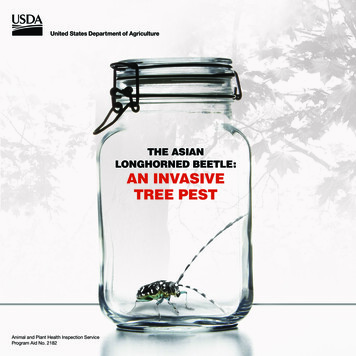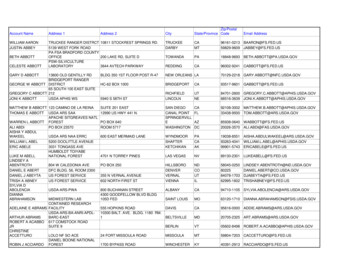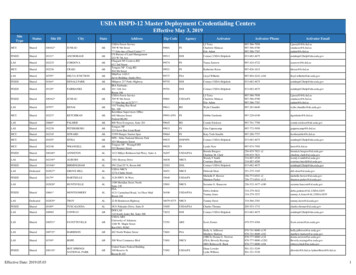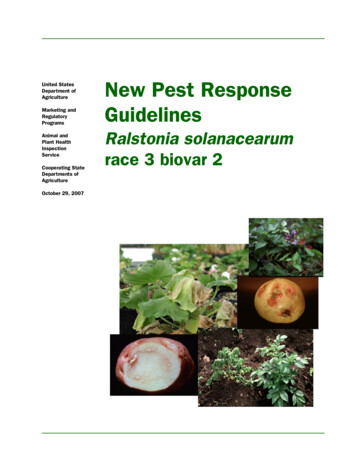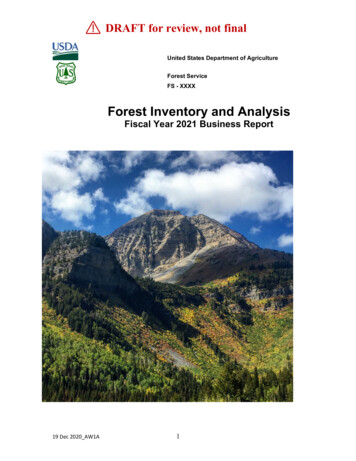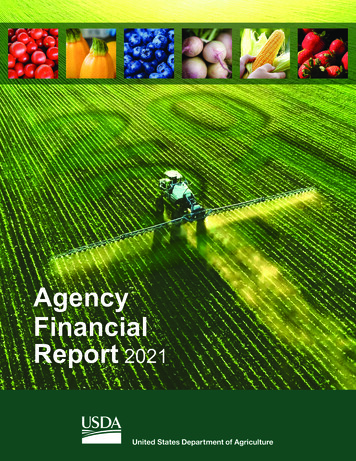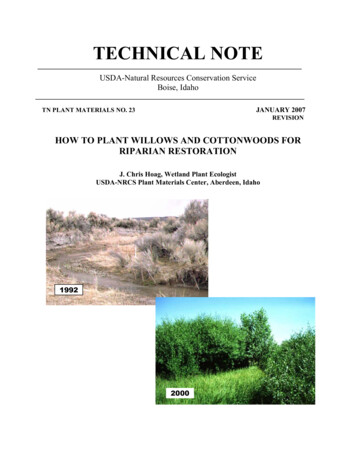
Transcription
TECHNICAL NOTEUSDA-Natural Resources Conservation ServiceBoise, IdahoJANUARY 2007TN PLANT MATERIALS NO. 23REVISIONHOW TO PLANT WILLOWS AND COTTONWOODS FORRIPARIAN RESTORATIONJ. Chris Hoag, Wetland Plant EcologistUSDA-NRCS Plant Materials Center, Aberdeen, Idaho19922000
HOW TO PLANT WILLOWS AND COTTONWOODSFOR RIPARIAN RESTORATIONJ. Chris Hoag, Wetland Plant Ecologist,USDA-NRCS Plant Materials Center, Aberdeen, IdahoIntroductionMany riparian areas in the West needrehabilitation. Natural climatic events andabuses in the past have caused the destructionof vegetation and accelerated streambank andstream bottom erosion (Kauffman and Krueger1984; Skovlin 1984; Platts 1981; Thomas andothers 1979). Emphasis on water quality,aesthetics, wildlife, and fisheries has promptedinterest in methods for revegetating erodingstream channels (Carlson 1992; Carlson et al.1991).There is increased interest in rehabilitatingriparian zones with willows and cottonwoods.Streambank erosion in a corral and feedingThe Interagency Riparian/Wetland Plantcomplex on Medicine Lodge Creek nearDevelopment Project, USDA NaturalDubois, IDResources Conservation Service (NRCS),Plant Materials Center (PMC), Aberdeen,Idaho and others are researching harvesting, storage, planting techniques and cultural practices forsuccessful establishment of willows, cottonwoods and other riparian woody vegetation to better meet theneeds of riparian rehabilitation.Guiding Principles of Stable Stream ChannelsRiparian vegetation is a critical part of any stream system. Riparian plants provide a huge web of rootsthat hold the soil together. They also provide significant roughness from their above ground biomass.Determining where to plant them is often one of the hardest decisions to make. Before starting to restorea stream channel, 3 principles need to be understood (Natural Channel Designs, 2006). They are:1. Elevations should rise away from the central channel.The central channel flow line must be the lowest point across the riparian area and the channel banks,floodplains, and terraces should slope upward continuously away from the channel. The banks will bemost stable if they can be stepped as they rise away from the channel. All flat areas should slopetoward the river. If they are level or slope away from the river they will tend to divert overbank flowsaway from the main channel and could contribute to greater erosion. Banks on the outside ofmeanders are expected to rise more rapidly than those on the inside, but should still be stepped whenpossible.2. Transitions should be gradual to reduce the potential for erosion.In order to minimize the risk of lateral bank erosion, water should flow smoothly through the streamcorridor. While meander is a natural part of stream processes, tight turns can create excessive pressureto weak stream banks and increase erosion. Meanders should be gradual and within the dimensions2
described in specific recommendations. Floodplains and terraces should not be suddenly narrowed bybuildings or other structures. Such constrictions force increases in velocity and water elevations thatcan increase erosion.3. Roughness should increase away from the central channel.Roughness is resistance to flow contributed by vegetation, rough surfaces, or structures. Increasingroughness away from the central channel tends to center high flows and slows velocities against themore erosive stream banks and terraces. For example, the central channel should be relatively free ofvegetation and other obstructions. The areas immediately adjacent to the channel (floodplains) shouldsupport dense thickets of shrubby vegetation (i.e., willows, etc) that bend with the flows (Figure 1).Areas further away from the channel (terraces) support stiffer woody vegetation (cottonwoods,Peachleaf willow, etc) that further slows flows. It should be noted that roughness implies a slowing ofthe flow not necessarily stopping the flow. Structures that completely stop or redirect flow across thefloodplain/terrace should be avoided.HomesPasture,Orchards, etcCottonwoods, Tree Willows,Denser BrushShrubbyWillowsFigure 1: Roughness - Vegetation provides increasing roughness to keep high velocities in central channel(Natural Channel Design, 2006)This Technical Note addresses principle 3 - the addition of roughness to the channel. It should be notedthat planting vegetation in a riparian zone without giving serious consideration to where different speciesof plants should go can cause more problems than those you are trying to fix. For more information onwhere to plant riparian vegetation, see Riparian Planting Zones in the Intermountain West by Hoag et. al.2001.There are a number of steps that should to be completed prior to any planting. They include a siteassessment, an inventory of planting site, and a detailed survey and evaluation of the soils, water, andvegetation. Once you have determined the cause of the erosion and where high priority areas are locatedon the stream, you should develop a planting plan and determine where and how to plant the vegetationthat you will use. This Technical note describes how to select, harvest, treat, and plant riparian woodyspecies.Site AssessmentBefore jumping into the water and shoving cuttings in the ground, it is important to understand what iscausing the streambank erosion, how extensive it is, and which areas need the most work. A streamassessment should be completed on the stream prior to any restoration or rehabilitation work. The3
assessment should identify problems on a stream reach basis. A is defined as a section of stream betweentwo defined points (Fischenich 2000). A number of assessment protocols are available, such as: StreamVisual Assessment Protocol (SVAP), Proper Functioning Condition (PFC), Rapid Stream Assessment,etc. The assessment should identify problems such as, water removal, fish barriers, culverts, etc. thataffect fish and hydrology by stream reach. It should also identify eroding areas, the type of erosion, andseverity of the erosion. When the assessment is completed, there should be enough information toidentify the reaches of the stream that need some kind of treatment, treatment alternatives that could beused, which reaches are the highest priority, other problems that need to be addressed, and an estimate ofthe potential success of a planting. Based on a good site assessment, you should be able to develop aproject rehabilitation schedule or plan including a list of treatment alternatives, a cost estimate for eachreach, a cost estimate for the entire project area, and a priority list of which reaches should be treated first.Site ConsiderationsCareful planning before planting is necessary to ensure the solution does not create additional problems.* Management (prescribed grazing system, livestock exclusion, riparian buffers, etc.) must be inplace to maintain or improve riparian vegetation. Without proper management, planting effortscould be destroyed (Crouse and Kindschy 1984; Van Haveren and Jackson 1986).* If native willows or cottonwoods are not found in the vicinity, planting them may not be a goodoption.* Willow and cottonwood plantings apply only to situations where the rehabilitation time frame islong enough to allow the cuttings to become established and stabilize the site. Hard structures (i.e.rock, concrete, etc.) may be more appropriate under emergency situations.* Unrooted cuttings can be used on sites that range from flat to near vertical slopes. Risks ofwash-out and mortality increase as the slopes become steeper.A reconnaissance upstream and downstream of the site selected for revegetation may save time and effort.If there are willows and cottonwoods on adjacent sites, check the hydrology, soil and site conditions andcompare them to conditions at the revegetation site. Plantings will be most successful on sites similar tothe stable vegetated areas. Risk of mortality increases as soil, site, and water column parameters departfrom those of the vegetated sites.There are reasons for vegetation not growing on the disturbed site. Some parameters to inventory inaddition to management at the revegetation site include: high streamflow velocities, sharp outside curves,vertical to near vertical or undercut banks, hanging streambanks, mixed stratigraphy of cohesive materialsover gravel, and evidence of mass soil slumping. When these parameters are present, revegetation can stillbe considered, but the underlying causes must be addressed. Establishing vegetation is much moredifficult under these conditions because the time period required for stabilization increases, the plantingschedule must accelerate, and additional soil losses can be expected.These conditions indicate engineered hard structures or bioengineering techniques not covered in thisTechnical Note need to be included in the planning considerations.Some data suggests vegetative protection may be adequate if maximum streamflow velocities do notexceed 8 feet per second. Structural and bioengineering techniques should be considered for velocitiesgreater than 8 feet per second. Woody materials should be considered with velocities less than 8 feet per4
second. Woody materials in conjunction with herbaceous species should be considered for velocities lessthan 5 feet per second. Herbaceous materials alone can be used for velocities less than 3 feet per second.Engineered hard structures or bioengineering techniques may be needed in situations where the toe of thebank is unstable. In these situations, refer to the NRCS Stream Restoration Design Handbook, NationalEngineering Handbook, Section 654.Species SelectionDuring the reconnaissance, identify willow, cottonwood and other riparian species, local soil and siteconditions and the moisture regime. If species identification is a problem, at least identify the growthform and conditions where the plant is growing (elevation, soils, zone, etc.). Species and/or growth formidentification is important so the correct plant species can be matched to the right planting zone at therevegetation site.Willow species have several different growth forms. Willows come in all sizes, from small shrubs to largetrees. There are three basic types of willows: tree-type, shrub-type, and creeping type. Tree-type speciesat maturity have a large crown, single or multiple stems, and dense basal area. They are usually tallerthan 20 ft. Shrub-type willows generally have smaller diameter multiple basal stems and rarely get tallerthan 15-18 ft. Creeping–type willowssucker profusely and are represented byDifferent growth forms of willows along the Snake Rivercoyote willow (Salix exigua).near Buhl, IDCottonwood species have narrow to widecrowns and some species sucker (generallyonly about 10% of a stand will sucker)while others have very shallow rootsystems.In general, small to medium size shrubtype willows and rhizomatous or creepingtype willows are used for planting withinthe channel banks. These can be planted aslive poles, vertical bundles or as clumps.Tree-type willows and cottonwoods arenormally selected for the upper bank andfloodplain areas near the transition zoneand can be planted as large poles orclumps.Mature size and growth form will affectspecies selection. Large species can partially block or deflect stream currents. If the mature basal size ofthe selected species will block streamflow near the main channel or on adjacent floodplains, anotherspecies with more flexible stems should be considered.There are many species of willows that occur naturally in different habitats. Upland willow species arefound in relatively dry areas not necessarily associated with seeps, bogs, or high water. Scouler willow, acommon upland species, is rarely found on wet areas, but more commonly on or near moist areas such assprings or intermittent watercourses. Wetland willows are found growing in standing water or saturatedconditions and are adapted to long periods of inundation.5
If spreading of planted species is considered a problem, selection might include only male clones. Bothwillows and cottonwoods have male and female plants. Selecting male plants will reduce spreading fromseeds.More shade will be produced with tall and/or wide canopy species. This may be important for watertemperatures and fish habitat. Consider the aspect. Concentrate on tree-type species with wide canopieson the south or east side of stream to achieve the most shade over the widest area.Stem flexibility is important for species at thewaterline to mid-bank on streams with highvelocities, debris loads, and ice flows (Parsons1963; Platts and Rinne 1985). Species withdeep or rhizomatous root systems might bebetter suited to streams with severe ice flows(Platts and Rinne 1985).Livestock and wildlife can adversely impactthe riparian zone. Some plant species such aswillow, cottonwood, chokecherry, Skunkbushsumac, golden current, serviceberry, Syringa(mockorange), and silver buffaloberry areDebris caught on the flexible stems of Booth willowfairly palatable. It may be advantageous toafter spring runoffplant less palatable species, such as hawthorn,in the bank to overbank zone rather than morepalatable species. Other less palatable species include: Woods’ rose, Douglas spirea, dogwood, riverbirch, thinleaf alder, and common snowberry.Grazing can also reduce regeneration, particularly for those species that reproduce by seed. Speciesselection of strong suckering or rhizomatous species may be an advantage. Improper grazing managementcan adversely impact even these species. A grazing management plan is needed whenever riparian areasare grazed, especially after planting. The riparian area should not be grazed for at least 3 years afterplanting. At the end of 3 years, the area should be assessed for grazing potential and if allowed, be grazedaccording to a good grazing management plan. Spring grazing is the best because animals have manyforaging choices other than the planted woody species. Be careful with fall grazing because woodyspecies are a more desirable foraging choice and there will be no regrowth before the next spring growthperiod. Overgrazing the woody and herbaceous riparian species will result in less bank and floodplainprotection during high runoff events the following spring. The woody riparian species should be used asthe key indicator species for when the livestock should be moved out of the riparian zone.Aesthetics can usually be improved by selecting more than one species to provide differences in size,shape, color, and texture. More than 1 species or clone also increases resistance to pests and diseases, inaddition to increasing diversity for wildlife. However, the species planted at the waterline should be asingle species so that all the cuttings have similar characteristics for the full length of any one reach sothat varying sizes and shapes do not cause the force of water to move behind that planted line.6
Most species of willow and cottonwoodhave good fire tolerance and resproutreadily after being burned as long as thefire is not too hot. Many cottonwoods aremore susceptible to fire as they mature.Other riparian species such as dogwoodand chokecherry also have a high firetolerance.There may be times when native specieswill not meet the landowners’ objectives.Introduced species should only beconsidered in the revegetation plan aftercareful review of the native sources (morenative species are available on the marketall the time), landowner objectives, andA riparian buffer with different species ondisease and insect infestations. Refer toBear Creek, IAthe Idaho Tree Planting Handbook, NorthDakota Tree Handbook, andRiparian/Wetland Project Information Series No. 19 for plant characteristics.Species Distribution or Planting DesignA planting design should be developed to show where each species is to be planted on the site. The entireproblem section should be planted, not just parts of a reach or curve. This will reduce the chance of watereroding behind the planting.Figure 2: Riparian Planting Zones can be used to determine where riparian species should be planted inrelation to the waterline. This is a general depiction of a riparian zone. Not all streams look like this one. Inthe real world, some of these zones may be absent. (From Hoag 2001, Hoag and Landis 1999)7
Each species grows in specific ecological zones along the stream channel and flood plain (Carlson et al.1992). These ecological zones can be equated to planting zones. Riparian planting zones (Hoag 2001)include the toe zone, bank zone, overbank zone, transitional zone and the upland zone (Figure 2).Shrubby species are normally planted on outside curves of a stream channel as a continuous barrier.Outside curves incur more erosion from streamflow, but have a shorter inundation period. Plant the entirereach with the same mix of species. Shrubby species with flexible stems are planted on the bank zone andthe overbank zone or floodplain for diversity and additional stabilization or as a buffer zone.Plant tree species up the bank from the shrubby species or on top of the bank. The shrubby speciesprovide protection for the tree species when planted in this manner.The reconnaissance survey will help identify these relationships. See "Spacing" section to help withplanting design and to help determine numbers of plants or cuttings needed.Type of Planting StockCuttings, whips, plugs, conetainers, bare-root, potted, clumps, balled and burlap, and paper-sleevedplanting stock are all viable alternatives (Carlson et al. 1992; Dirr and Heuser 1987; Platts et al. 1987).Advantages of nursery stock include: good potential root development, good carbohydrate reserves, fewpest or disease problems, readily available for many species, and no labor is needed to collect the stock.Disadvantages of nursery stock include: more expensive than hardwood cuttings collected near therevegetation site, short root systems can wash out easily, short root system may not reach moist soilduring the growing season, and roots of local herbaceous vegetation are in the same zone competing formoisture and nutrients.Stem cuttingsStem cuttings can be divided into softwood, semi-hardwood (greenwood), and hardwood categories.Hardwood stem cuttings can also be divided into deciduous, narrowleaf evergreen, and broadleafevergreen (Dirr and Heuser 1987). This Technical Note concentrates on deciduous hardwood cuttingsfrom moderate age stem materials. Deciduous hardwood cuttings of willow and cottonwood species aregenerally recommended over other types of cuttings because of the high concentration of pre-formed,8
dormant root primordia located throughout the length ofthe stems (Densmore and Zasada 1978; Carlson 1938,1950; Haissig 1970, 1974).Pole cuttings (large diameter unrooted stems) of shrubtype willows are recommended for most plantings fromwater line to mid-bank. Pole cuttings of tree-type willowsand cottonwoods are recommended on upper-banks andfloodplains where the water table is relatively deep. Polecuttings provide an effective means to reach saturated soilsand establish a high concentration of roots for that portionof the stem within the moist zone.Pole cuttings have the additional advantage of beingrelatively inexpensive and easy to harvest and store. Theyare also easy to plant. High mortality can occasionallyoccur, but this is somewhat offset by lower cost, ability torapidly plant large numbers, and ease of replanting thefollowing year.Generally, whips (less than 3/8 inch diameter) are not recommended because energy reserves in the stemare limited and they are more susceptible to cytospora canker, a fungus that causes twig dieback (Biggs etal. 1983; Briggs 1991).Container stockPlugs, conetainers, bare-root, potted, balled and burlap andpaper-sleeve planting stock are best when used:*mid-bank to upper-bank or floodplain where long periods ofinundation or water erosion are minimized*where adequate moisture is available -- i.e. naturalprecipitation or irrigation is adequate for species selected*where there is no competing vegetation or a 30" diameterarea around plant has the competing vegetation scalped offdown to mineral soil at planting time*where plants have a low risk of physically being pulled oreroded out due to shallow rooted systems duringestablishmentSource of Cuttings from Commercial StockWillows and cottonwoods have been used extensively for riparian rehabilitation because they are easilyestablished from cuttings. Cuttings can sometimes be obtained from commercial nurseries or morecommonly from native stands located near rehabilitation sites. When buying cuttings from commercialsources, released varieties of adapted species should always be specified when available.9
PMCs conduct extensive research and testing with native willows and cottonwoods collected from servicearea states having similar climate, soils, and topography. Once a willow or cottonwood meets the testingcriteria, it is released to the public. Commercial nurseries and growers then propagate the species on amuch larger scale for sale. The released variety name is the key to getting a plant adapted to conditionssimilar to where it was tested. All named varieties have documentation that describes growthcharacteristics, performance, and selection criteria. This ensures they are the same stock as originallytested.Plugs, conetainers, bare-root, potted, and paper-sleeved nursery stock purchased through nurseries shouldbe established from local materials. This could be from a local ecotype or the same watershed, but shouldnot be from more than 200 miles east or west or 100 miles north or south or more than 2000 feet elevationdifference from planting site. Ask the nursery where the stock came from.Source of Cuttings from Native StandsNative willow and cottonwood stands located near the rehabilitation site are the most common source ofcuttings. Native stands of willow and cottonwood are adapted to local conditions, but may have or havehad insect and disease infestations which can stress the plants in the potential "mother" stand. Low wateryears and long periods of drought may also stress the plants. This stress means that the stem cuttings maynot have peak energy reserves. Low energy reserves translate into lower establishment success.When planning the number of cuttings to harvest, take these stress indicators into account. Always obtainpermission to harvest from the landowner, private or public, before starting to cut.Timing of HarvestEstablishment success is significantly increased if cuttings are taken from live, dormant willows orcottonwoods either after leaf fall in late fall, winter, or very early spring before the buds start to break.Densmore and Zasada (1978) found that spring collections survived better than fall collections. However,studies in Idaho have found no such differences (Hoag 1991; Hoag et al. 1991; Hoag et al. 1992). See"Storage" section for procedures when harvesting well before the projected planting date.Placing a large diameter willow pole intoa hole created by The Stinger in rockriprapIn some cases, when access to the stream is limited due toregulatory concerns or during fish migration periods (i.e.during salmon migration runs in the spring and the fall),planting may be restricted to non-dormant periods. Ratherthan do nothing, consider harvesting the cuttings when theplants are in full leaf. When cuttings are harvested duringthese growth stages, expect the establishment success rate todecrease. Experiments at the Aberdeen Plant Materials Centerhave shown that when the plants are leafed out and harvested,the establishment success is about 40-50%. If you plan toplant during the active growing season consider planting morecuttings to make up for the lower success rate.Cutting DiameterCuttings should generally be 3/4 inch diameter or largerdepending upon the species (Briggs and Munda 1992; Hoag1991; Hoag et al. 1991; Hoag et al. 1992; Fenchel et al. 1988).10
Rhizomatous or spreading willow stems will rarely get much bigger than 3/4 inches in diameter. Treetype willows can be several inches in diameter. Larger diameter cuttings have more energy and storedreserves than smaller diameter cuttings. Highest survival rates are obtained using cuttings 2 to 3 inches indiameter. Cuttings as large as 8 inches in diameter have been tested with excellent success (Carlson et al.1991; Hoag et al. 1992). However, the larger the cutting diameter, the longer the cutting should be, andthe deeper the hole should be to support it. The deciding factor for selecting the cutting diameter is theplanting method you will use (see Planting Methods). Larger diameter and longer cuttings will be neededfor more severely eroding sites and where the water table is deeper. When planting into rock riprapcuttings should be at least 3- 5 inches in diameter. Cuttings this size will not bend or break when pushedbetween the rocks in the riprap.Cutting LengthCutting length is largely determined by the depth to the mid-summer water table and erosive force ofstream at the planting site (Briggs and Munda 1992; Fenchel et al. 1988; Hoag 1991; Hoag et al. 1991;Hoag et al. 1992). Plantings can occur at the water line, up the bank, and on top of bank in relatively drysoil, as long as cuttings are long enough to reach into the mid-summer water table. Make sure:* 6-8 inches of cutting are in the mid-summer water table* 3-4 buds are above the ground* No less than 1/2 the total length is in the ground* If long periods of inundation exceeding 30 days are likely, cuttings should be long enough toextend 6-12 inches above the expected high water level* If weeds are a problem, the cutting should extend above herbaceous growth in summer toreceive adequate light and below the weed root mass to minimize competition (Hoag et al.1991; Platts et al. 1987)When planting for bank stabilization, the cuttingshould extend 2-3 feet above ground so as it leafsout, it can provide immediate bank erosionprotection. The cutting should be planted as muchas 3-5 feet into the ground (sometimes deeper toensure they are in the mid- summer water table).If they are not planted this deep, moving watercan erode around cutting and rip it out of theground. Tests have shown that even withestablished root systems as long as 15-28 feet, theerosive power of a stream can rip a short cuttingout of the ground (Hoag 1991; Hoag et al. 1991;Hoag et al. 1992).Boyd Simonson standing next to coyote willowcuttings that were 20 ft long11
Harvesting CuttingsOnce cutting size and source locations have been determined, the actual cutting process can begin.Lopping shears, pruning shears, a small wood saw, brush cutters, or a chain saw can be used to harvestcuttings. Size of the cuttings will determine what you use to harvest them.* Ensure all equipment is sharp and make clean cuts.* Use live wood at least 2 year old or older. However, very old wood should not be used (Briggsand Munda 1992; Fenchel et al. 1988). Chmelar (1974) indicated that larger and older wood isrequired to propagate species that are difficult to root. The best wood is 2-7 years old withsmooth bark which is not split or deeply furrowed.* Avoid whips and suckers (current year's growth) because they lack the stored energy reservesnecessary to consistently sprout when planted especially in dry conditions.* No more than 1/3 of any individual plant should be removed. In the case of rhizomatousspecies, no more than 40-50% of the stand should be removed.* Select branches which will not impair the source willows health and appearance.* When harvesting from native stands, ensure the stand will not be denuded or destroyed by yourcutting activity.* Consider removing cuttings from inside the crown area rather than the more visually obviousexterior area. Try to spread your harvesting activity throughout the stand.* Remove the apical bud plus several inches off of the cutting. The apical bud (bud at the tip ofthe branch) draws too much energy from stored reserves, reducing the chance of survival. Itsremoval will reroute energy to the side buds including the root buds. The upper part of the12
stem also has the flowering parts (Kay and Chadde 1992). By cutting it off, energy is alsoredirected to the root and branch primordia in the older parts of stem.* Trim off all side branches so cutting is a single stem.* A processing consideration is to cut the top of cutting with a horizontal cut and bottom ofcutting with a 45 degree cut. This allows quick recognition of cutting top (see also SealingHarvested Cuttings).* Care should be taken to select materials free of splitting, disease, and insect damage.Painting Harvested CuttingsOne of the most important steps in this process is the identification of the TOP of the cutting. If cutting isplanted upside down, significant mortality can occur. To identify which end is the top of cutting, look atthe leaf scar and emerging buds. Buds emerging from leaf scar always point up. In addition, the stem isusually smaller diameter near top of cutting, but this is not always obvious. The leaf scars are the mostreliable key.When the top of cutting has been identified, it can be painted. Dipping the TOP 1-2 inches of cutting intoa 50:50 percent mix of light colored latex paint and water, does a number of things. Perhaps the bestreason for painting the top of cuttings is it helps inexperienced planting crews plant cuttings properly,with the top up! It also helps locate the cuttings more easily for future planting evaluations. It may alsoprevent excessive transpiration of water from cutting (the literature is mixed on this point, but AberdeenPlant Materials Center research shows a higher establishment rate can be expected) This technique isinexpensive, easy, and effective.Painting the tops of willow cuttingsStorageThe preferred timing for harvesting willow and cottonwood cuttings is when they are dormant. Tominimize storage time, harvest cuttings in late
USDA-Natural Resources Conservation Service Boise, Idaho TN PLANT MATERIALS NO. 23 JANUARY 2007 REVISION HOW TO PLANT WILLOWS AND COTTONWOODS FOR RIPARIAN RESTORATION J. Chris Hoag, Wetland Plant Ecologist USDA-NRCS Plant Materials Center, Aberdeen, Idaho 1992 2000. 2 HOW TO PLANT WILLOWS AND COTTONWOODS . Tree Willows, Denser Brush Pasture .

